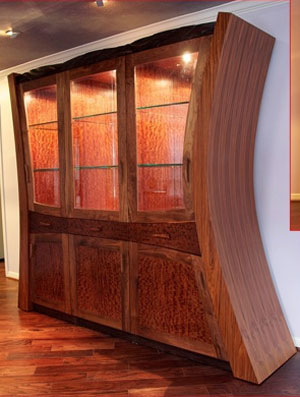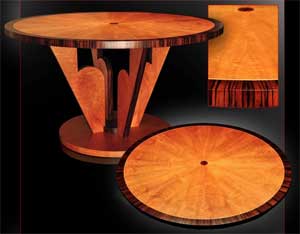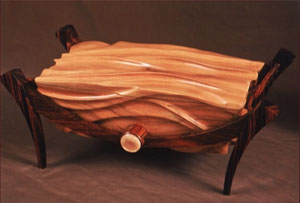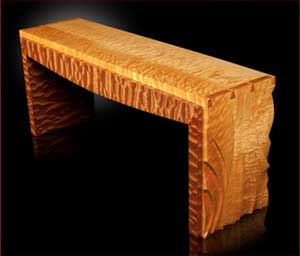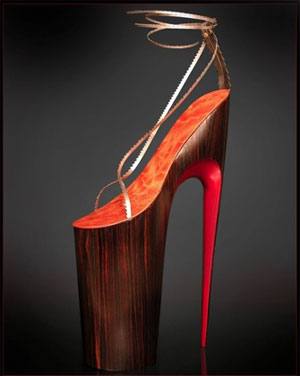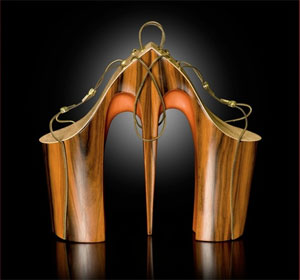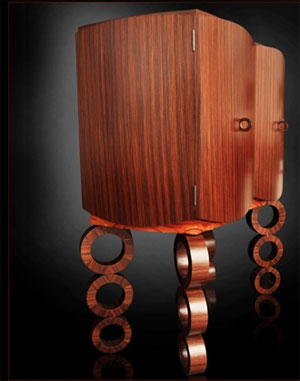
Although Omar Angel Perez had been doing woodworking “on the side” since college, it was after being part of a recession-related downsizing a few years ago that he became a full-time woodworker — who incorporates skills from his previous work background into his woodworking pieces.
Formerly a television designer — he has an Emmy for excellence in broadcast design — Omar found that his background with three-dimensional animation makes him able to see his projects three-dimensionally, too, before he’s built them. “I’m able to see how a person would see something by walking around it,” he said. “A cabinet, for instance, doesn’t just have a front; it has a back also. The legs in back can have interesting things happen with them also, not just the ones in front.”
He does sketch out his designs while building them, but, Omar says, “I always try to start out with a question, like ‘Why does a table have to have four legs?’ or ‘Why do corners have to be corners?’ I start out with a very blank parameter of what things have to be, and then I start taking things away or adding to it.”
Omar is making these pieces with what he calls basic woodshop items — not a lot of hand tools, but things like a planer and a table saw — and “basic hand cut joinery: tongue-and-groove, mortise-and-tenon; nothing really extravagant.”
In that way, it’s not a whole lot different from when he first started doing woodworking. “I saw Norm Abram on This Old House one weekend and thought, ‘I can make that.’ That’s kind of how it started. I was in college at the time, and tired of living on cinder block furniture.” Omar started scavenging through wood piles for material, making shelves, frames, and “whatever could be made with a straight cut” while using a hand rotary saw, a drill, a jigsaw and some basic carpentry tools.
A self-taught woodworker with no formal training, Omar continues to learn as he explores different directions in his work. He tries to do something different nearly every year, “just trying to keep it fresh. For me, it’s hard to keep doing the same type of piece all the time.”
Recently, for instance, he’s been working with veneering. He’s discovered that you can find what he calls “exquisite” examples of woods like rosewood and ebony for use as veneers, and, with every project, he says, it gets better. “You learn to see what the veneer will do for you, how it looks when it’s book-matched. You don’t know exactly what it’s going to look like until you start putting the finish on it.”
Omar’s preferred finish, by the way, is a Sam Maloof-inspired mixture of turpentine, tung oil and spar varnish. “I love to put it on,” he said.
He also enjoys woodworking as a whole. “I enjoy what the piece does to my client, how they interact with it. I really enjoy the process that comes with shaping it. The smell that comes with woodworking — it’s overall kind of sensory.”
His favorite project, because of the personal aspect, was his own home: Omar and his wife did all of their own interior woodwork, from floors to ceilings, to cabinetry and built-ins. The two-year-long project, Omar said, “To me, it was the hardest woodworking project I’ve done, but also the most fulfilling at the same time.”
His most unusual woodworking project is likely his series of Stilett “O”‘s: wooden sculptures of high-heeled shoes. “It started out as a joke,” Omar explained. His wife is a photographer who takes pictures of all the pieces he builds, and “All my male buddies know I’m kind of a leg man: I enjoy seeing women in high heels. I think it changes their personality, the way they look. So I made one one day and I called to my wife, ‘I’ve got something I need you to take a picture of.'” The something was the first wooden Stillett “O,” titled, “My Shoes Are Killing Me.”
While laughing, Omar said, his wife assured him both that he was crazy and that the concept was kind of fun. The Stilett “O”‘s have become their own series, but they still utilize the same skills and materials as in Omar’s other projects. “All the heels have a mahogany base,” Omar said. “The band saw blade is my idea of what women go through: they’re cutting into you.”
With any of his work, Omar said, “I consider my pieces as functional sculpture.” For the most part, “They still have to be ergonomic and useful, but very artistic at the same time.”
